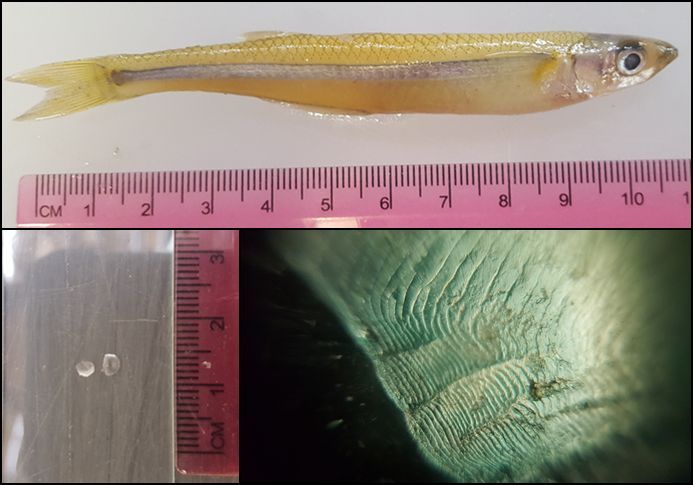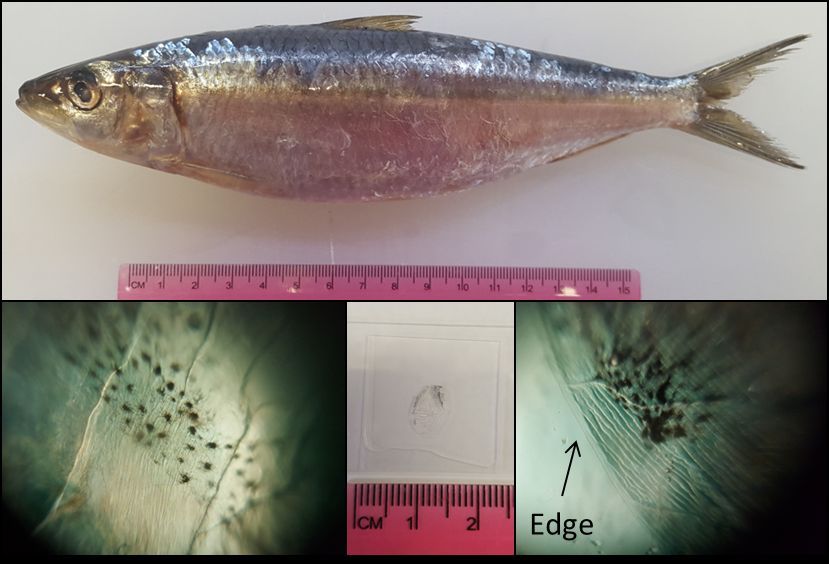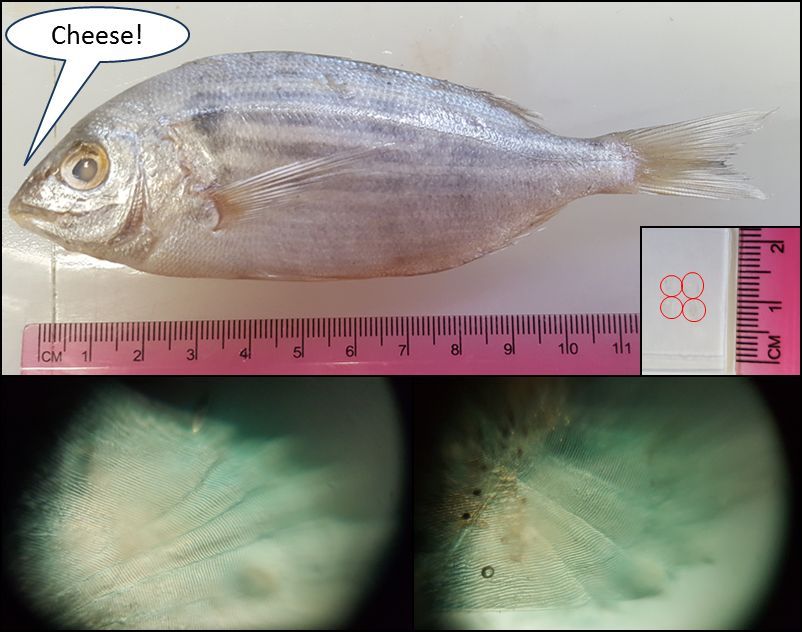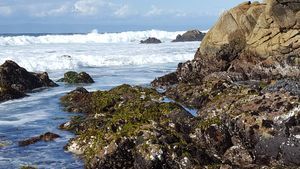Fun with Fish Scales
 Apr 29, 2017 • 12:22 PM UTC
Apr 29, 2017 • 12:22 PM UTC United States
United States 140x Magnification
140x Magnification Microorganisms
Microorganisms
AHolder
Learn about the author...
3posts
2comments
3locations

Having become more familiar with using the Foldscope on pickleweed in the Elkhorn Slough and being inspired by barnacle cirri at Point Piños , I wanted to take a look at some other animal structure under the Foldscope. The first thing that came to mind was fish scales, since I thought they would be easy to put on a slide and view under the scope. So, I called a friend of mine, Alexander Norton, at the Tuna Research and Conservation Center (TRCC) in Pacific Grove, California, and asked him to set aside some fish samples. The TRCC is a collaboration between Stanford University’s Hopkins Marine Station and the Monterey Bay Aquarium . When I volunteered at the TRCC a few years ago, I got to support their research on the respiration of Pacific bluefin tuna ( Thunnus orientalis ) and yellowfin tuna ( Thunnus albacares ) under various conditions. Having spent time at the TRCC, I knew it was the perfect place to get a variety of fish scales.
Fun Facts about Fish Scales
There are four main types of scales: Placoid (found on sharks and rays), Cosmoid (found on lungfishes and some fossil fishes), Ganoid (found on fishes such as paddlefishes and sturgeons), and Cycloid and Ctenoid (found on the majority of bony fishes). Scales provide fish with external protection. Those fish that don’t have scales, like clingfishes (family Gobiesocidae), protect their bodies with a thick layer of mucous. Scales vary in size and shape, and fish can have more than one type of scale on their body. Some species even have different scales based on their sex (males have one type females have another). The rings on Cycloid and Ctenoid scales indicate feeding events over time, so they can be used to estimate the growth rates of fish, much like growth rings on trees. Scales under the Scope
Alex was able to put aside quite a few fish samples for me. I was not able to identify all fish down to species, so a general description of a few of the specimens with the most interesting scales is provided below.
Smelts (family Osmeridae) are found in the Pacific and Atlantic oceans. They are small, iridescent fish that feed on invertebrates and small fishes and are prey to larger fishes. They are also commercially harvested for human consumption .
Below, you can see the specimen from which I obtained the scales (top), the scales on the slide, which are only a couple of millimeters wide (bottom left), and what one of the scales looked like under the Foldscope (bottom right). The scales were a bit difficult to see on the fish, but as soon as you look at them under the magnified lens, you can clearly see the wave-like curvature of the scale and the growth rings.
Fun Facts about Fish Scales
There are four main types of scales: Placoid (found on sharks and rays), Cosmoid (found on lungfishes and some fossil fishes), Ganoid (found on fishes such as paddlefishes and sturgeons), and Cycloid and Ctenoid (found on the majority of bony fishes). Scales provide fish with external protection. Those fish that don’t have scales, like clingfishes (family Gobiesocidae), protect their bodies with a thick layer of mucous. Scales vary in size and shape, and fish can have more than one type of scale on their body. Some species even have different scales based on their sex (males have one type females have another). The rings on Cycloid and Ctenoid scales indicate feeding events over time, so they can be used to estimate the growth rates of fish, much like growth rings on trees. Scales under the Scope
Alex was able to put aside quite a few fish samples for me. I was not able to identify all fish down to species, so a general description of a few of the specimens with the most interesting scales is provided below.
Smelts (family Osmeridae) are found in the Pacific and Atlantic oceans. They are small, iridescent fish that feed on invertebrates and small fishes and are prey to larger fishes. They are also commercially harvested for human consumption .
Below, you can see the specimen from which I obtained the scales (top), the scales on the slide, which are only a couple of millimeters wide (bottom left), and what one of the scales looked like under the Foldscope (bottom right). The scales were a bit difficult to see on the fish, but as soon as you look at them under the magnified lens, you can clearly see the wave-like curvature of the scale and the growth rings.

Sardines (family Clupeidae) are small epipelagic fish, found in the Pacific and Atlantic oceans that swim in large schools. They feed on zooplankton and are an important forage fish for larger marine fish, mammals and birds. Sardines are fished commercially and are used: as bait for other commercial or recreational fisheries, for reduction to fish meal or oil for animal feed or other products, or for human consumption where they are commonly eaten fresh, dried, salted, smoked, or canned.
Below you can see the specimen, which would later be used to feed some tuna at the TRCC. In this case, you can see the scales all over the fish’s body (top). The scale on the slide is less than one centimeter wide and had some dark spots (bottom center). In the image on the bottom left , you can see the pigmentation on the scale up close and what appears to be tiny explosions. My colleague and I hypothesized that this was a result of cells containing pigment bursting during the freezing process. The image on the bottom right is my favorite of the two because you can see the pigmentation, growth rings and the edge of scale.
Below you can see the specimen, which would later be used to feed some tuna at the TRCC. In this case, you can see the scales all over the fish’s body (top). The scale on the slide is less than one centimeter wide and had some dark spots (bottom center). In the image on the bottom left , you can see the pigmentation on the scale up close and what appears to be tiny explosions. My colleague and I hypothesized that this was a result of cells containing pigment bursting during the freezing process. The image on the bottom right is my favorite of the two because you can see the pigmentation, growth rings and the edge of scale.

I was not able to identify the last specimen with certainty, but I think it may be an east coast snapper. Either way, I loved this set of photos because the fish looked like it was smiling, which elevated its cuteness index far above the other specimens. As you can see in the inset on the right, the scales were small (the largest being four millimeters long) and almost entirely transparent, so it was difficult to know where to place the slide under the lens. Can you see the scales within the red circles?

Once I was able to see the scales under the lens, they were clear as day. Much to my surprise, they looked a lot like the smelt scales in that they had a similar wave-like shape and you can see neat lines of growth rings. It seems like this perch may have had many more (and more frequent) feeding events than the smelt above.
Until next time, happy Foldscoping!
Until next time, happy Foldscoping!
Sign in to commentNobody has commented yet... Share your thoughts with the author and start the discussion!

 0 Applause
0 Applause 0 Comments
0 Comments